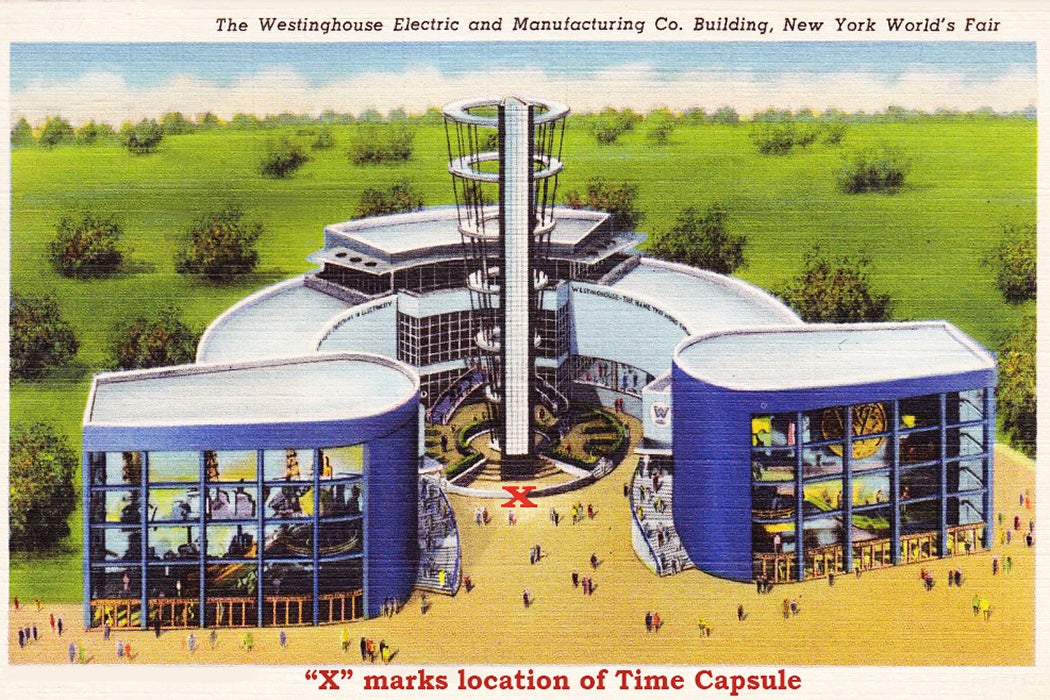Maybe you participated in one at school, selecting some objects to be locked away, or maybe you saw one being opened. I’m writing, of course, about that strange cultural phenomenon, the time capsule. There was a flurry of time capsules being created or opened through the second half of the twentieth century, reaching a peak around the year 2000.
Although the term “time capsule” was coined at the 1939 New York World’s Fair, time capsules as a concept date back to the Gilded Age and Progressive Era, when autographs, photographs, and other artifacts were sealed in various cities. But to what purpose? According to historian Nick Yablon,
the frequency of time capsule deposits at the time of important anniversaries (of the nation or of states and cities) and at the turn of centuries (most recently, the millennium) might lead us to conclude that they operate merely as commemorative objects, providing an occasion for patriotic self-congratulation and momentary political consensus.
But he explains that the impetus behind “time vessels,” as he calls them, was more nuanced, reflecting the politics and controversies of the era.
The ease of creating a time capsule (of some kind) is reflected in the fact that many don’t contain items of great import. He points out that the contents often “duplicat[ed] documents that remain available in libraries.” So, the intent wasn’t to save or preserve items that wouldn’t otherwise survive. Instead, what was chosen reflected the values of those who had the power to choose or approve the contents.
The century-plus craze for capsules means that there could be “hundreds of forgotten time capsules that have overshot their target date and remain below ground today, their location and contents now unknown,” writes Yablon. This sounds exciting in theory but turns out to be slightly less so in practice.
In 1976, when President Ford was about to open an 1879 capsule with unknown contents, he hedged his bets, claiming that “there is no safe big enough, to contain the hopes, the energies, the abilities of our people,” regardless of what was in the box. Alas, much like Geraldo Rivera’s opening of Al Capone’s vault in 1985, the result was a bit of a letdown.
“The prosaic contents—an inkstand, a scroll, an autograph and photograph album, and various miscellanea—proved ‘rather a disappointment for those present,’” writes Yablon, quoting contemporaneous news accounts.
But the 1970s saw some even bolder attempts to send capsule messages to those temporally and geographically distant. The plaques included on the Pioneer 10 (1972) and Pioneer 11 spacecraft launched in 1973 and the gold records on Voyager 1 and Voyager 2 in 1977 were also time (and space) capsules, reflecting our hopes and anxieties.
William E. Jarvis finds them more “akin to cornerstone repositories than to modern terrestrial time capsules, because the Voyager Record and Pioneer plaque capsules lack a definitely scheduled retrieval date.” Cornerstone repositories, a tradition going back for centuries in Europe, involved placing items in the cornerstone of a new building during construction. Although related to time capsules, they also had a kinship to placing hidden tokens or tributes in a building for good fortune or blessing. And unlike time capsules, they weren’t intended to be opened or retrieved later.
Jarvis also finds a pattern in the term of the time capsule—it’s either fairly short or incredibly long.
“While at least seven millennial (one thousand years or more) time capsules have been deposited between 1939 and 1979, centennial time capsules, like the building cornerstone repositories they resemble, are quite common,” he writes. “Most…conform to this millennial-centennial distinction: there are very few time capsules sealed for more than one hundred or less than one thousand years.”
Weekly Newsletter
Take the Crypt of Civilization, buried at Oglethorpe University in Atlanta, Georgia. Sealed in 1940 and destined to be opened in the year 8113, the Crypt is
a twenty-foot-long, ten-foot-high chamber…massive for a time capsule, consisting of granite walls lined with vitreous porcelain enamel embedded in pitch. The stone floor (two feet thick) rests on a bedrock of Appalachian granite, and the stone roof is seven feet thick.
Inside the chamber are hundreds of items, notes Jarvis. Future crypt-crackers will find
a model train, a toy log construction set, male and female mannequins in glass cases, a pair of binoculars, an Emerson radio, a glass refrigerator dish and cover, an electric toaster, a pair of stockings, dentures (upper), a plastic flute, a glass rolling pin, a quart of beer, a lighted makeup mirror, a life-sized cutaway model of a pregnant woman, phonograph records typifying several kinds of music, and two DuMont television receivers.
Jarvis sees in this ambitious project the influence of the opening of Egyptian tombs in the early twentieth century. Those tombs, especially that of Tutankhamun, revealed (mostly) untouched collections going back thousands of years. Thus, the Oglethorpe Crypt of Civilization intends to project twentieth-century life thousands of years into the future.
Most time capsules, of course, are nowhere near this ambitious, but they still have goals. Yablon describes the creation of the capsule as involving “safeguards against oblivion”—protective measures for the container itself to survive, be found, and be opened at the right time. But metaphorically, “safeguards against oblivion” is what they seek to be: a wish to not be forgotten.
Look! Time Capsules on JSTOR
Support JSTOR Daily! Join our membership program on Patreon today.







